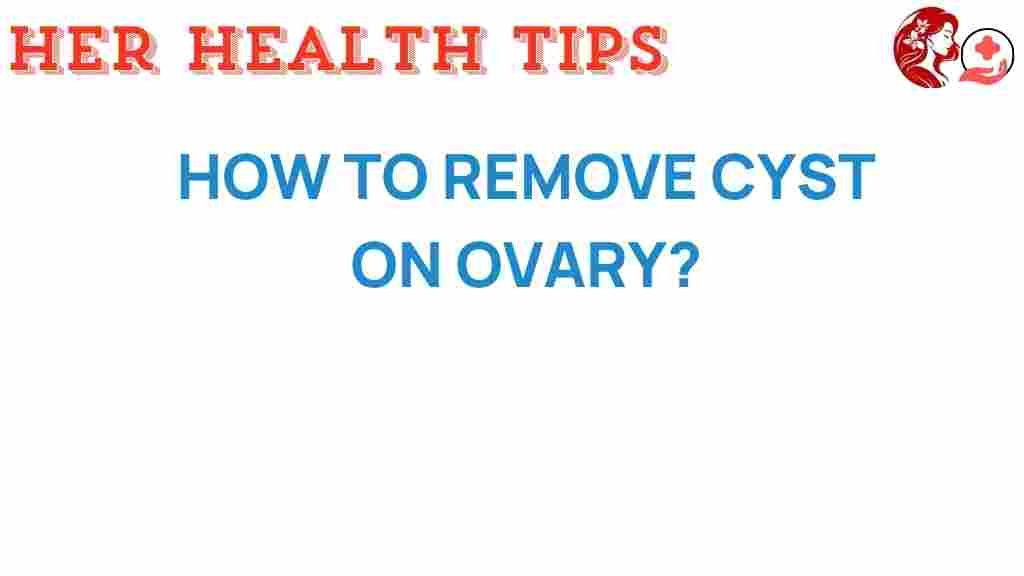Unlocking the Mystery: How to Effectively Remove an Ovarian Cyst
Ovarian cysts are fluid-filled sacs that can develop on the ovaries, and they are a common health issue affecting women of reproductive age. While many ovarian cysts are harmless and may resolve on their own, understanding the various removal and treatment options available is essential for ensuring women’s wellness and effectively managing symptoms. This article will explore the diagnosis, symptoms, treatment options, and alternative therapies related to ovarian cysts, guiding you through the process of dealing with them.
Understanding Ovarian Cysts
Ovarian cysts are often categorized into two types: functional and pathological. Functional cysts occur as a part of the normal menstrual cycle, while pathological cysts may arise from abnormal cell growth. Here’s a closer look:
- Functional Cysts: These are the most common type and typically harmless. They include follicular cysts and corpus luteum cysts.
- Pathological Cysts: These include dermoid cysts, cystadenomas, and endometriomas, which may require more extensive treatment.
Recognizing the symptoms of ovarian cysts is crucial for timely diagnosis and treatment. Common symptoms may include:
- Pelvic pain or discomfort
- Menstrual irregularities
- Abdominal bloating or fullness
- Frequent urination or difficulty emptying the bladder
- Pain during intercourse
Diagnosis of Ovarian Cysts
Upon experiencing symptoms, it is important to consult a healthcare provider for a proper diagnosis. The diagnostic process may involve:
- Pelvic Examination: A healthcare provider will manually assess the pelvic area for abnormalities.
- Ultrasound: This imaging test helps visualize the cysts and determine their size and type.
- CA-125 Blood Test: This test measures the level of a protein that may indicate the presence of ovarian cancer, especially in postmenopausal women.
Treatment Options for Ovarian Cysts
Once diagnosed, the next step is determining the appropriate treatment option. The choice of treatment for ovarian cysts depends on several factors, including the size and type of cyst, symptoms, and the patient’s overall health. Here are some common treatment options:
1. Watchful Waiting
Many functional cysts resolve on their own without intervention. In such cases, a healthcare provider may recommend:
- Regular monitoring through follow-up ultrasounds
- Keeping track of symptoms
2. Medication
Hormonal contraceptives, such as birth control pills, may be prescribed to:
- Regulate menstrual cycles
- Prevent the formation of new cysts
However, medication may not eliminate existing cysts but can help manage symptoms.
3. Surgical Intervention
If cysts are large, persistent, or cause significant symptoms, surgical removal may be necessary. The main surgical options include:
- Laparoscopy: A minimally invasive procedure where small incisions are made, allowing the surgeon to remove the cyst using a camera and specialized instruments.
- Laparotomy: A more invasive procedure used for larger cysts or if cancer is suspected, involving a larger incision in the abdomen.
After surgery, recovery time varies, but many women can return to normal activities within a few weeks.
Alternative Therapies for Ovarian Cysts
In addition to conventional treatments, some women explore alternative therapies to manage ovarian cysts and improve overall wellness. These may include:
- Dietary Changes: Incorporating a diet rich in fruits, vegetables, and whole grains while reducing processed foods may help support hormonal balance.
- Herbal Remedies: Some herbs, like chaste tree berry (Vitex), may aid in regulating menstrual cycles.
- Stress Management: Practices such as yoga, meditation, and acupuncture can promote relaxation and hormonal balance.
While alternative therapies can complement traditional treatment, it is essential to consult with a healthcare provider before starting any new regimen.
Troubleshooting Tips
Here are some troubleshooting tips to consider if you experience symptoms of an ovarian cyst:
- Keep a symptom diary to track changes and discuss them with your healthcare provider.
- Consider lifestyle changes such as regular exercise, a balanced diet, and stress reduction techniques.
- If you notice severe symptoms, such as sudden intense pain, nausea, or fever, seek immediate medical attention.
Conclusion
Understanding ovarian cysts is key to managing women’s health effectively. With various treatment options available, including watchful waiting, medication, and surgery, women can find the appropriate path to recovery. Additionally, exploring alternative therapies can enhance overall wellness and symptom management. If you’re dealing with ovarian cysts or need more information, consult with your healthcare provider for personalized guidance.
For further information on women’s health and ovarian cysts, you can visit this resource.
If you’re looking for community support and experiences related to ovarian cyst removal and treatment, check out this forum.
This article is in the category Reproductive and created by HerHealthTips Team
